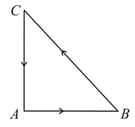Addition and Subtraction of Vectors
Addition and Subtraction of Vectors: Overview
This topic covers concepts, such as, Addition and Subtraction of Vectors, Addition of Vectors, Position Vector & Negative Vector etc.
Important Questions on Addition and Subtraction of Vectors
The scalar components of the vector with initial point A (2, 1) and terminal point B would be:
The magnitudes of vectors are and units respectively. If , then the angle between is :
Given that Two out of the three vectors are equal in magnitude. The magnitude of the third vector is times that of the other two. Which of the following can be the angles between these vectors?
Three forces starts acting simultaneously on a particle moving with velocity These forces are represented in magnitude and direction by the three sides of a triangle (as shown). The particle will now move with velocity

Which is true about negative of a vector?
Addition of vectors is not commutative.
Which triangle is formed by the points whose position vectors are ?
Which triangle is formed by the points whose position vectors are ?
Find the square of magnitude of the vector joining two points and in .
A vector of magnitude units along the vector is
Let and be three vectors. The area of the region formed by the set of points whose position vectors satisfy the equations and is closest to the integer.
Find a value of for which is a unit vector.
Find the position vectors of the points which divides internally and externally in the ratio the join of points and .
Prove that in any , where a,b and c are the magnitude of the sides opposite to the vertices A, B and C, respectively.
P and Q are two points with position vectors and , respectively. If the position vector of a point R which divides the line segment PQ in the ratio 2:1 externally is , then
For given vectors, and , if the unit vector in the direction of the vector is , then value of is
The sum of the vectors , and is of the form . Find the value of .
If , , and where denote the sides of the right-angle triangle. Then, find the value of .
If , then find the value of , if so that may be a unit vector.
If unit vector in the direction of the vector is given as , then find the value of .
